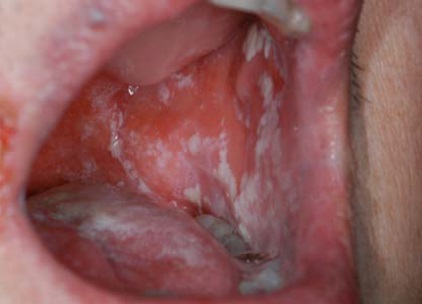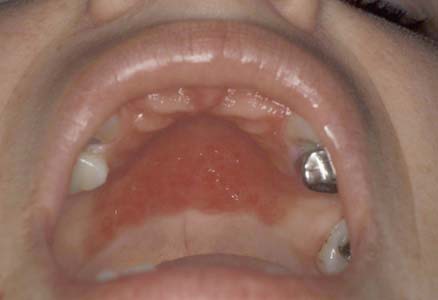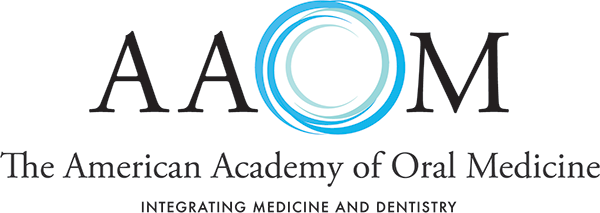Oral Yeast Infections
An oral yeast infection (aka thrush or candidiasis) most commonly appears as white cottage cheese-like plaques on any surface inside the mouth. Less commonly, it may appear as red irritated areas inside the mouth. This red form is often present on the tissues of the mouth that are covered by a denture or other prosthetic appliance.
An individual with a yeast infection may complain of pain or burning in the mouth or a change in taste sensation. However, many patients have no symptoms at all.
Patients at an increased risk of developing an oral yeast infection include:
- newborn babies
- patients receiving chemotherapy or radiation treatment for cancer
- patients with HIV infection
- patients receiving tissue or organ transplantation
- patients with dry mouth secondary to disease, aging, or as a side effect of drug therapy
- patients wearing upper dentures
- patients taking steroids and / or antibiotics

Oral yeast infection ‐ Multiple white “cottage cheese‐like” plaques surrounded by areas of redness.
|

Oral yeast infection ‐ Red irritated areas affecting tissues normally covered by a removable partial denture.
|
QUESTIONS AND ANSWERS ABOUT ORAL YEAST INFECTIONS
Q: Is the condition contagious? Did I catch it somehow? Can I give it to anyone else?
A: The truth is that many people have yeast in their mouth, but it seldom overgrows to such an extent that it becomes visually apparent or produces symptoms. Yeast can be passed from one individual to another, but this is not a clinical problem unless there is some other factor at work that allows the yeast to overgrow and cause an infection.
Q: What causes a yeast infection?
A: In most individuals, the yeast organism (Candida albicans) is a normal part of the many microorganisms that harmoniously reside in the oral cavity. Infection typically occurs when the normal oral environment is disturbed or altered in such a way as to promote increased yeast growth (see patients at increased risk above).
Q: How can a yeast infection occur under my denture?
A: The area underneath the denture is a warm, dark, and moist place—a perfect incubator for yeast! Also, if the denture is always covering the roof of the mouth, the tissues are not cleaned of any yeast that may build up during the day. Dentures should always be removed and properly disinfected overnight.
Q: How can my dentist treat a yeast infection?
A: Most importantly, your dentist will evaluate you to determine the underlying cause or causes of the infection. Once this is accomplished, your dentist can tailor a treatment plan to best manage the infection. In some cases, attention to improving denture hygiene is all that is necessary. When necessary, medications (antifungals) are prescribed to stop the yeast from growing. These range from topical rinses and lozenges to pills taken by mouth. Finally, when the underlying cause is beyond the scope of dentistry, a medical consultation may be warranted.
Prepared by S Redding and the AAOM Web Writing Group
Updated 21 October, 2015
Japanese Translation - 日本語訳
Spanish Translation - Traducción Español
The information contained in this monograph is for educational purposes only. This information is not a substitute for professional medical advice, diagnosis, or treatment. If you have or suspect you may have a health concern, consult your professional health care provider. Reliance on any information provided in this monograph is solely at your own risk. |


